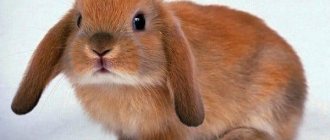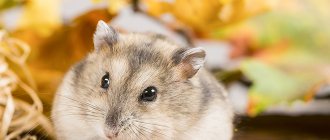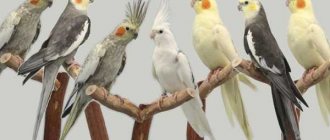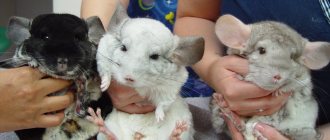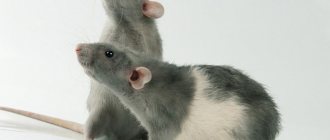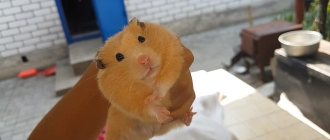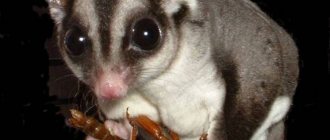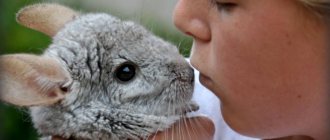Expert opinion
Dobryshev Sergey Anatolievich
Professional rabbit breeder and hare breeder with 30 years of experience
Proper care of rabbits is vital to the business called rabbit farming. This guarantees the production of a healthy, full-fledged population of animals capable of producing tasty dietary meat and beautiful fluffy fur.
The rules for caring for rabbits are not particularly complicated, but they require compliance with the necessary requirements and vigilant attention.
How to feed rabbits mash
Mash is an excellent choice for nutrition. Rabbits eat them with pleasure. Sometimes such mixtures are the main ones, especially in small rural farms. This popularity is associated with significant savings. In addition, mixed mixtures perfectly saturate the animal’s body with nutrients.
| The following are often added to mash mixtures: |
| • straw; • carrots, beets, potatoes (peeling them); • onion peel; • cabbage leaf; • melons, their peels (pumpkin, zucchini, watermelon, melons); • crushed legumes, grains; • remains of meat and fish products (chopped, dried); • porridge, noodles; • steamed feed; • grass meal • chopped straw; • meat and bone meal; • table salt, chalk, vitamins. |
The mixture should have a fairly viscous consistency so that it does not spread and does not stick to animal fur. During production, a base is prepared into which the remaining ingredients are mixed. Excellent binding bases are boiled mashed potatoes, pumpkin puree, clover or alfalfa juice.
Approximate ratio of ingredients in rabbit mash
| Mash base (40-60%) |
| • Boiled potatoes and peelings • Steamed beet pulp • Silage, table waste • Boiled vegetable waste |
| Concentrates (30-40%) |
| • Compound feed • Crushed grain (oats, barley, wheat, corn) • Wheat bran • Grass meal |
| Protein and vitamin supplements (5-20%) |
| • Meat and fish meal • Boiled or dry minced fish and meat waste • Whey • Feed yeast |
| Minerals (1-2%) |
| • Bone meal • Chalk • Table salt |
It is convenient to give mash to rabbits in the form of “cutlets”, because they simply do not eat porridge well. Such “cutlets” can be dried in the oven, sprinkled with bran or rolled in sunflower cake, dried nettle or fine hay.
Veterinary and sanitary rules for staffing rabbit farms
According to the current veterinary and sanitary rules, recruitment and replenishment of rabbit breeding farms is allowed only with healthy rabbits from farms known to be free from infectious rabbit diseases. Rabbits selected for sale for breeding purposes are separated into a separate group for preventive quarantine a month before leaving the farm.
While rabbits are in quarantine, veterinary specialists of the state veterinary network serving this territory subject them to a thorough clinical examination, diagnostic tests and treatments. In the future, for each shipment of rabbits sent, the veterinary specialist of the state veterinary network issues the 4th or 1st form of veterinary certificate, which confirms the well-being of the sent rabbits for infectious and parasitic diseases. Upon arrival, the rabbits must be placed in a quarantine facility for a month. During the quarantine period for rabbits arriving at the farm, a clinical examination of rabbits, diagnostic studies and preventive treatments are carried out in accordance with the epizootic situation in a given locality or region.
Prevention of infectious and invasive diseases in rabbits.
To keep rabbits healthy, rabbit breeders must follow general rules for caring for them. Cages and feeders must be cleaned every day. Once every 10 days, owners must disinfect everything contained in the cage. Observe the zoohygienic parameters for keeping rabbits. In recent years, the successful development of rabbit breeding has been hampered by the emergence of infectious diseases of rabbits in the country that cannot be treated. Among these diseases, the most dangerous are myxomatosis and viral hemorrhagic disease of rabbits.
Myxomatosis is an infectious, acute, highly contagious viral disease characterized by serous-purulent conjunctivitis, edematous and gelatinous infiltration of tissue in the head and external genitalia, and the formation of tumor nodules on the skin. For more information about the disease, see our article – “Myxomatosis”.
Rabbit viral hemorrhagic disease is an infectious, acute, highly contagious disease that is characterized by a very rapid spread among adults, accompanied by high mortality. More details in our article “rabbit viral hemorrhagic disease”. Rabbit breeders often have to deal with such a parasitic disease as rabbit coccidiosis. More details in our article “coccidiosis of rabbits”. Among the infectious diseases in rabbits, there are such diseases as rabbit pasteurellosis, rabbit pox, rabbit treponemosis, infectious rabbit fibromatosis.
In their practical activities, rabbit breeders are faced with such widespread diseases of rabbits as ear diseases in rabbits, diarrhea in rabbits, worms in rabbits, staphylococcosis in rabbits, streptococcal septicemia in rabbits.
Animal care
Your pet should be groomed regularly and its cage should be kept clean.
The cage should be cleaned every two to three days, and leftover food should be removed every day. The water in the drinking bowl is also changed daily. This will not only benefit the animal, but will also rid the apartment of unpleasant odors and debris around the cage. The cage should be disinfected with special solutions that are safe for the pet’s health. You need to wash the cage with hot water, and then treat it with a weak solution of potassium permanganate. The rabbit needs to be examined regularly, checking the ears, nose, eyes and fur. At the slightest deviation from the norm, you should contact a veterinarian. Redness of the eyes, nasal discharge, dull fur, immobile or lethargic state of the animal, and lack of appetite should cause alarm. The animal should be brushed regularly with a special brush, especially if it has thick, long hair. This will help prevent tangles from appearing. You should not wash your pet; he can ensure his own cleanliness. Sometimes this is necessary, especially after walking in the fresh air. In this case, you should use only shampoo intended for rabbits, and rinse it off very carefully. It is necessary to constantly monitor the condition of the animal’s teeth. In order for your pet to grind them down on his own, his diet must include hard pieces of trees
The cage should also contain a red mineral stone; you can periodically add a small amount of crushed chalk to the food. Special attention should be paid to the rabbit's claws. In the wild, they wear off on their own, but this is impossible at home, so they should be carefully trimmed as they grow, approximately once every three weeks.
For the first time, you should ask for the help of a veterinarian, carefully observe this process, and then carry out the procedure yourself using special scissors sold in pet stores. This should be done extremely carefully so as not to damage the vessels located inside the claws. The bones in rabbits' feet are very fragile, so they must be handled very carefully.
So, proper care for a domestic rabbit means wisely choosing and arranging a cage, regularly cleaning it, following the rules of feeding the animal, as well as regular examination of the rabbit to prevent its illness.
Contents in a cage
The place where the animal is kept should be convenient and comfortable: an enclosure, a house or a cage. The size is selected according to height: standing on its hind legs, the animal should not rest against the ceiling. It is better to make the pallet plastic and put a straw bedding on top.
It is not worth putting sawdust and straw on a pallet, because the baby rabbit will begin to relieve itself everywhere. For the toilet you need a tray filled with natural substances: sawdust, hay, soft paper, leaf shavings or straw.
The place where the animal is kept should be convenient and comfortable
The cage area can be divided: make a separate part for sleeping, eating, playing and toileting. The place to sleep can be slightly darkened, this will ensure comfortable rest and privacy.
It is better to place the feeder, drinker and hay bark separately. It is better to make a feeder for grain feed from a heavy material, such as ceramics. The animal will not be able to knock over the bowl and play with the container, which will prevent severe contamination of the cage. It is allowed to fix the drinking bowl with the feeder on the rods.
You should not keep your rabbit in a cage all the time - this will cause skeletal deformation, obesity or another disease. The animal has an active and playful character, so it requires movement. You need to let him out for a walk around the room at least once a day.
Preparation for construction
To prevent animals from getting sick, you should first of all properly arrange the rabbitry. However, before you start arranging the premises, you should decide on the method of keeping living creatures.
Content options
There are 2 popular ways of keeping animals: free and caged. Preference should be given to the cellular method of maintenance, which has several advantages over the free method.
- For rabbits, diet is extremely important. Consumption of some herbs that grow everywhere can cause serious health problems. Cellular content eliminates independent search for food, and, accordingly, the risk of poisoning.
- When kept in cages, up to 20 animals can be accommodated in a small area.
- Breeding rabbits occurs according to a predetermined plan. When kept freely, it is impossible to keep track of mating.
- Allows you to select suitable individuals for mating. When kept freely, mating occurs spontaneously, and offspring will be produced not only by strong, but also by weak individuals.
- Cage keeping allows for timely identification of a sick individual and isolation of it from the rest.
- Cages are easier to care for than an aviary.
To eliminate the spread of infections and increase the comfort of life for your pets, you need to carry out regular cleaning
There is also pit or pit free housing. Its peculiarity is that the rabbits are in a hole dug in the ground. However, it is difficult to care for the livestock, monitor the mating of males and females, and provide the correct diet for each animal in such conditions.
Selecting a location
If kept freely, it is necessary to prepare the enclosure by fencing it with a chain-link mesh or other material that acts as a fence. On the territory of the enclosure it is necessary to install a rabbitry in which the animals can hide from bad weather and spend the night. Floor maintenance involves insulating the floor. You can give each rabbit a cage.
Cages are installed in open space or indoors. A garage or shed will do. A small number of rabbits can be kept even on the balcony of an ordinary apartment. However, even if sanitary and hygienic standards are observed, the place of detention has a specific smell that will be heard in the apartment, which is a significant drawback of apartment housing.
Keeping them outdoors involves choosing a place to install cages. Rabbits are afraid of drafts. It is better to prepare a place for installing cages near other rooms that will protect them from the wind.
Animals should not be exposed to direct sunlight. Although a too shaded place is also not the best option
It is important to find a middle ground here
You should not install pet houses in the lowest areas, where the air humidity level is often high. A hill is also not suitable - it is the windiest place.
Disease Prevention
One of the main conditions for properly caring for rabbits is timely vaccinations. There is a vaccination schedule that clearly states at what age and for what diseases they need to be done.
Rabbits are susceptible to colds and digestive disorders. Viral infections are possible. Sick animals should be immediately separated from the rest. It is necessary to be examined by a veterinarian and prescribed treatment.
Complete and competent care will allow you to raise healthy offspring.
How to feed and care
After giving birth, the nutrients that enter the rabbit’s body along with feed are spent on dairy products, and therefore the female must be provided with a rich and healthy diet, which contains the following components in sufficient quantities:
- proteins;
- vitamins;
- minerals.
During the postpartum period, the female must be provided with food that will promote the production of dairy products, such products include:
- vegetable tops;
- White cabbage;
- grass;
- rowan (berries);
- dry alfalfa in winter.
To improve lactation, the rabbit's body is provided with a large amount of fluid through succulent feed. This includes:
- zucchini;
- cucumber;
- carrot;
- watermelon;
- melon.
Such food saturates the body with moisture even in cases where the rabbit drinks little water from the drinking bowl. You can additionally give pre-sprouted dill seeds with parsley. This food is very useful, especially in the winter months, when there is a deficiency of vitamins and there is no grass. You should not overuse such feeds; they should be supplied in small quantities.
Feeding baby rabbits
An approximate daily diet for a lactating female can be compiled as follows:
- hay from legumes and forbs – 100-300 g;
- sunflower cake – 40 g;
- wheat bran – 30 g;
- grain legumes and mixed feed – 80 g;
- feed yeast – 5 g;
- bone meal – 7 g;
- feed chalk, salt, fish oil - 3 g of each ingredient.
Rabbits need constant care. The nesting house must maintain a certain temperature that is comfortable for the animals. This indicator is +30 °C. Lower temperatures lead to restless behavior of young animals. If we talk about caring for the little rabbits at this time on the part of the owner, then there is no need to do anything; the mother rabbit takes care of the little ones herself.
The owner is advised to monitor the behavioral characteristics of the animals; reduced activity may indicate the presence of a disease. You also need to constantly monitor the amount of water in the drinking bowls; there should always be enough of it. The vitamin complexes and mineral compounds necessary at this age are obtained from rabbit milk.
Feeding
Feeding animals in an apartment will not cause any trouble for a novice rabbit breeder; the most important thing is not to forget that rabbits are almost omnivores and eat a lot. The exact calculation of the need for feed can be determined experimentally, and it will depend on the weight of the animal. When it is necessary to prepare supplies for a year, one adult individual requires 350-600 kg of products, a third of which is hay or grass.
The summer diet of animals differs from the winter diet in the presence of vitamins, feed composition, and calorie content.
In summer, the best options for rabbits are:
- leaves of strawberries, grapes, lettuce, currants, raspberries and other trees and shrubs that grow in the garden,
- forbs, especially clover, dandelion, alfalfa, coltsfoot, nettle, plantain, rapeseed. Herbs should be given dry, or even better slightly dried, to improve the digestive system,
- dry food: compound feed, legumes and grains,
- some vegetables and fruits (pears, apples, zucchini, cabbage, etc.),
- root vegetables (beets, potatoes, Jerusalem artichoke, carrots, celery, etc.). Tubers must be without soil, clean, both boiled and raw,
- in winter, grass should be replaced with silage, straw, and hay. The winter diet must contain more nutritious and dry food than in the summer. For rabbits, table scraps (in addition to bones and meat dishes) are suitable as a variety.
- In winter, pine needles are required to provide animals with vitamins. Pine and spruce branches are the best way to add vitamin C to your diet,
- chalk must be added to the year-round daily menu, taking into account 1-2 grams, salt 0.7-1 grams per day,
- feeding newborn rabbits will require additional attention, given their still weak digestion. Therefore, only root vegetables and tender herbs are suitable for rabbits. Moreover, zucchini and pumpkin, boiled potatoes, and Jerusalem artichoke are useful for rabbits. But you must refrain from giving solid products (grain, straw, hay),
- The daily menu of lactating and pregnant rabbits needs to be varied and increased thanks to nutritious foods: legumes, grains, root vegetables, feed, bran,
- Rabbits are absolutely prohibited from feeding sour, rotten, moldy and other spoiled foods.
The following should be excluded from the daily herbal menu:
- wild rosemary,
- elderberry
- dope,
- wolf berries,
- foxglove,
- celandine,
- hemlock,
- henbane.
Introducing your pet and teaching it to your hands
Having bought a rabbit and delivered it home, you should give it time to adapt. These animals are very sensitive and can die from fear. Moving and changing the environment is very stressful for the animal. In the first few days, he will not be active, but will begin to sniff the home and look around.
It is necessary to accustom the animal to handling gradually. Immediately after purchase, the animal is placed in a cage and is not disturbed. When he gets the hang of it, you can offer your pet a piece of apple or carrot, carefully pulling the treat through the grill
At this moment you cannot make noise; it is important that the eared one takes the treat himself. Over time, he will get used to the smell of his owner’s hands and the sound of his voice.
After a few days, the animal is released from the cage for a walk around the room so that it gets comfortable there too. You can pet your pet if he doesn’t resist. It is not recommended to pick up your pet in the first days. This is done when the degree of his trust in the owner increases.
Attention! You cannot approach an animal from behind and stand over it, the animal will perceive this as a threat
Raising a teenage hare
Diet: at 2 months the hare no longer needs milk. His diet should consist of fresh berries, fruits and vegetables, as well as greens (grass, branches). You can add prepared foods to your food, but only grain-free ones. Vaccinations: Hares are given the same vaccinations as rabbits. It is better not to delay immunization, since hares raised on artificial feeding are much weaker and more susceptible to disease than their wild relatives. It is also advisable to give tablets against coccidiosis and helminths for preventive purposes. Contents: within a month he will be strong enough to walk around the house independently. All things dangerous for the bunny should be hidden, toys can be scattered below. The first few months of life are the best time for education, which consists of teaching the hare not to be afraid of new people, animals, loud sounds and medical procedures. It is extremely difficult to re-educate an adult hare. If it is possible to move your pet to an outdoor enclosure, this should be done no earlier than six months, when it is already fully strengthened.
Where and how to keep rabbits
Since the main goal of raising rabbits on our farm is to obtain meat, the entire technology is built accordingly. We raise fattening rabbits in a cage-free (free) manner in two wooden sheds covered with roofing felt. The breeding stock is located in two other wooden barns, but we keep these rabbits in individual cages so that we can control matings, litters, and wean young animals on time.
Each female rabbit produces offspring twice in a year. We try to organize mass births so that the young animals received for fattening are raised in groups, and if necessary, immediately after the birth, the number of rabbits in the nests is equalized. Therefore, all females are paired with males within 2-3 days. After giving birth, we keep the young animals with their mother for 3 months. This duration of the suckling period allows the rabbits to acquire strong immunity, and in the future there will be no problems with their health. Rabbits intended for fattening, aged from 2 to 4 months. open castration.
After weaning, young rabbits are combined into groups and transplanted into sheds for cage-free housing. We plan the entire reproduction cycle so that the animals reach the age of 8 months. (optimal slaughter time) in early to mid-December or early May. By this time, the animals weigh 3.5-4 kg (carcass weight - 1.5-2 kg). This seasonality can be explained simply - the demand for rabbit meat in the markets increases in connection with the New Year and May holidays.
We slaughter animals on the farm. We sell rabbit meat to regular resellers; we do not sell it on the market ourselves. In 2013, in our area, 1 kg of rabbit meat was valued at 220-250 rubles, so each carcass weighing 1.5-2 kg cost from 330 to 500 rubles.
The meaning of the game for rabbits
Rabbits have an active, playful disposition. The game is an important event for them. The pet must be provided with the necessary set of toys - it could be a ball, a fruit or vegetable made of wood, a maze, a wheel, etc.
Pet stores offer a wide range of entertainment devices. The presence of toys will save wallpaper, furniture and other interior items from the claws of the animal.
In the process of sharing an apartment with other animals, you can gradually make friends with them. Then fun games with a cat or dog will be added to the toys.
In the apartment and in the cage, the rabbit needs to arrange a special enclosure (playpen) for playing.
Methods for slaughtering rabbits
The slaughter of meat rabbits begins when the animals are 4 months old, and to obtain the skin, you must wait until they molt (about 6-8 months). Considering the nuances of growth and molting, the best time is from mid-November to early March.
Methods for slaughtering rabbits:
Electric. Take a 2-core cord with a plug and metal needles. One needle is inserted into the croup and the other into the head between the ears. After plugging into the outlet, current passes through the rabbit, causing instant death. Air embolism. Air is injected into the ear vein with a syringe. Death occurs in about a minute. Rolling of the neck. Hands fix the hind legs with the head. Then a sharp turn of the head to the side is made. Death is instant. Shooting pin. Requires a special pin that can shoot a long metal needle at the animal
It is important not to miss when shooting, otherwise the animal will suffer. If the needle passes through the intersection of straight lines (the first - from the right eye to the left ear, the second - from the left eye to the right ear), then the rabbit will die instantly. French
The rabbit is placed on a horizontal surface. They grab the ears and legs with their hands. When the animal quiets down, quickly spread your hands. The long-eared dies from rupture of blood vessels and tissues instantly. Throat cut. The carotid arteries and trachea are cut with a sharp blade. Death is instant. The disadvantage of this method is that blood leaks out, which spoils the skin. Mechanical (most popular). The rabbit is hit on the back of the head behind the ears with a round wooden stick - instant death.
Determining gender
Determining the sex of rabbits is an important and necessary task for those involved in breeding eared rabbits.
Immediately after birth and until weaning from mother's milk, it is very difficult and impractical to determine the sex.
As soon as the rabbits become more independent, it’s time to determine which of them is which. To do this, you need to place the individual on a hard surface. Holding the pet by the scruff of the neck, lift it and sit it on its tail. With the second hand, they open the fur in the genital area. In females, the genital slit should open, located close to the anus. Males have a round opening that is further from the anus than the female.
In males who have reached puberty, pronounced testicles can be felt.
Rules for caring for a dwarf rabbit
Decorative dwarf rabbits require careful daily care. In order for the animal to delight the family with its presence and good health for many years, the following recommendations should be followed:
- Keep your animal's eyes, ears and genitals clean every day. The appearance of tearfulness, an unpleasant odor from the ears or excessive accumulation of wax is a reason to consult a veterinarian, as they may indicate the onset of a disease;
- wash the animal under warm water in case of diarrhea or contaminated fur with feces;
- monitor the condition of the teeth - for continuous grinding, rabbits need a constant presence of fresh hay, twigs and solid food in the cage. If the diet is improper, the teeth will grow too quickly, which will inevitably lead to poor health of the animal - loss of appetite, refusal to eat;
- 1-2 times a month it is necessary to trim the claws with a special device - a nail clipper. When removing overgrown claws, you need to act carefully so as not to disturb the condition of the blood vessels;
- You should comb the fur of a miniature rabbit at least once a week. For long-haired pets, the combing procedure is carried out daily to avoid the appearance of tangles.
Diet of dwarf rabbits
When feeding dwarf rabbits, you should follow the recommendations of experts. The animals' diet should contain a large amount of vegetables (cucumbers, radishes, carrots), dried fruits (bananas, raisins, dried apricots), green leaves and fresh hay. The drinking regime is of great importance - the presence of settled, clean water in the cage is mandatory.
For good health, it is recommended that pets be given vitamin and mineral supplements, and the dosage of pharmaceutical drugs should be agreed with a veterinarian.
The diet of miniature ornamental rodents should contain a maximum of useful substances and microelements
Approximately the menu of a young mini-rabbit should look like this:
| Feed | Volume |
| Fresh hay | 150 g – for individuals with straight ears 200 g – for lop-eared breeds |
| Freshly cut succulent food (clover, dandelions, nettles, cereal sprouts) | Up to 8% of body weight |
| Washed vegetables (broccoli, carrots, cauliflower, rutabaga, radishes, cucumbers) | 1-1.5 cups/1 kg of animal weight, starting with small doses and gradually increasing |
| Fruits (apple, banana, pear, papaya) | 1 tablespoon, up to 4 times a week |
| Dry granulated food (specialized, only for this type of animal) with a protein content of up to 18% | 1-2 tablespoon (2.5-3% of body weight) |
| Salt | 0.5-2% of total food |
In winter, it is necessary to enrich the animals’ diet with vitamin preparations and use granulated feed
Fresh vegetables and fruits are an essential part of the daily diet for rabbits
Proper care, a sufficient number of walks and a well-designed diet are a guarantee of longevity for dwarf rabbits living at home. A grown animal can be walked outside using a harness or leash. A decorative rabbit is easier to keep than traditional pets, and a well-groomed and healthy rodent can evoke the warmest feelings among all family members.
Hygiene procedures
A decorative rabbit needs constant care and health care. It is also necessary to follow the vaccination schedule - this will protect against a dangerous disease. You should not treat the animal yourself; it is better to contact an experienced veterinarian.
Nail care
The animal's claws are constantly growing. Veterinarians advise trimming them every 2-3 weeks. You should not leave claws untrimmed because of the risk of injury to the animal or yourself during play.
You need to ask someone for help to carry out the procedure. The animal must be held tightly so that it does not twitch during cutting and damage to the blood vessels at the base of the claw does not occur.
The length of the claws after the procedure is 2-3 mm. If a vessel is suddenly damaged, the bleeding can be stopped with 3% hydrogen peroxide.
Grooming
It is recommended to brush long-haired breeds daily to prevent the formation of tangles. During molting, the combing procedure is increased to 2-3 times a day.
Bathing is prohibited for rabbits. It is allowed to bathe only when the fur interacts with chemical compounds. The animal is cleaned in separate sections.
When baby rabbits leave the nest
All rabbits begin to leave the nest at three weeks of age. Getting to know the “adult” world involves some nuances:
- From this moment, acquaintance begins not only with the external habitat, but also with “adult” food - the baby rabbits try food from their mother’s feeder, which should only contain products that are harmless to babies. Gradually, the eared animals will move from such complementary foods to the normal diet of adults.
- During this period, it is necessary to change the bedding in the cage so that the miniature rabbits do not get dust into their eyes. The best option is to temporarily lay down a clean, thick cloth or towel.
- Breeders conduct a control examination of the physiological development of the offspring. If it is discovered that the rabbits are not growing well, then the rabbit’s menu is immediately revised or the baby rabbit is transferred to a female with more high-calorie milk. If there is a weakened rabbit in the brood, it is better to remove it from the nest so that the female rabbit does not begin to notice the difference among the cubs and does not abandon the entire brood because of this.
- From the 28th day, rabbits begin to be vaccinated against diseases according to the approved vaccination schedule.
Video Inspection on the 3rd day after birth
Why do baby rabbits leave the nest early?
When a mother rabbit throws her cubs out of the nest or the baby rabbits begin to emerge before three weeks of age, there may be several reasons for this behavior:
Lack of milk in the female. A decrease in the amount of rabbit milk or a decrease in its nutritional properties indicates that the rabbit is not eating properly. To restore normal lactation, you should review the eared mother’s diet, make it more nutritious, and adjust the diet and volume of food. Taking good care of your rabbit is the key to getting healthy offspring from her. If lactation cannot be restored, then the offspring are placed with another lactating rabbit or artificially fed.
Increase in air temperature in the queen cell. In order for the baby rabbits to feel comfortable and cozy, the temperature in the nest should be controlled. When it becomes very hot and stuffy, the problem can be eliminated by moving the cage to a cooler room or to the open air under a canopy.
It is important to remember that the rabbits should not emerge from the queen cell before the due date. If this problem occurs, you should quickly find and eliminate the cause, otherwise you may lose the brood
When can weaning take place?
It is recommended that older rabbits be separated from their mother no earlier than 1.5 - 2 months of age, provided that they already eat full adult food, do without milk, and do not get sick. The weaning procedure is carried out gradually, removing 2 rabbits from the litter daily. In this way, the female will physiologically and painlessly stop lactation.
Typically, females are placed in cages of 3-4 individuals, and males are castrated or transferred to individual cages (provided they are kept for breeding).
After weaning, the most important aspect is the diet of the young animals. They should receive a high-calorie diet rich in proteins and carbohydrates. It is recommended to enrich the food composition with mineral and vitamin premixes. If 3-4-month-old young animals gain weight well and quickly, then the transition to adult food has taken place well, and the selected nutrition meets all the nutritional needs of actively growing organisms.
Video NEWBORN BABIES
Puberty
Having bought a rabbit to keep at home, you should think about whether it will have a mate. At the age of 3–4 months, rodents begin puberty. At the same time, pets become restless and even aggressive. Males mark their territory by scattering droppings. The owner will have to make a decision - to resort to castration of the animal or get him a mate.
Reproduction
Sexually mature individuals reproduce quickly. At home, females are ready to mate almost every month. After mating with a male, pregnancy occurs, which lasts 28–32 days. In one litter, from 5 to 12 rabbits are born. It is important to consider in advance whether it is advisable to keep a couple of rabbits at home.
Castration
Most pet owners resort to castration or sterilization. This procedure is carried out from the age of four months in a veterinary clinic. After it, rabbits are not able to reproduce, their behavior returns to normal.
Attention! Castration allows you to extend the life of an animal, since its body does not wear out as quickly as that of individuals that bear offspring.
Review of the best breeds
Features of maintenance and nutrition directly depend on the selected breed of animal. So, you can keep downy, fur-bearing or meat rabbits. The best representatives of each category are described below.
Meat
New Zealand rabbit
The weight of an adult New Zealand rabbit breed can reach 5 kilograms. The animal's body is well-built and there is no excess fat on the muscle tissue. The rabbit's color is white, the body itself is compact, the muscles are well developed, the head is small in size with erect short ears, a strong constitution, and the skeletal system is well developed.
A distinctive feature of the breed is its active growth at an early age (a three-month-old rabbit can reach 3 kilograms). New Zealand females are highly fertile and can feed up to 12 cubs. The paws of these animals are covered with thick hair, which allows them to be kept in cages with a mesh bottom without the threat of pododermatitis.
Ram
This breed also has its own distinctive feature - long ears, for this property the breed received its second name - fold. Sheep are a meat breed that is extremely popular in Western Europe. The length of a rabbit can reach 70 cm, weight is 7-8 kg.
Representatives of the species have a strong, well-built body, and their meat has excellent taste. Females are capable of producing 9 cubs per litter. The life expectancy of a decorative rabbit is 13-15 years with proper care.
Downy
White down
In the Russian expanses, the breed is represented by several varieties with different weights of individuals and different quality of fluff. Among this breed there are also individuals with black and blue colors.
The average weight of the animal can reach 4 kg, the constitution of adults is strong, the body length is about 55 cm. Female rabbits have average fertility, one litter brings up to 7 young rabbits.
Angora
The Angora rabbit, which looks more like a fluffy ball, is popular as a pet. This breed is loved for its playful and friendly nature.
The weight of an adult individual reaches only 3 kg; rabbits have rather slow growth rates; at the age of six months they reach a weight of only 2 kg. A female rabbit can give birth to up to 6 babies in one litter. The disadvantage of this breed is the need for regular grooming and keeping only in a warm, dry, spacious place.
The most common types of hares
The snowshoe hare acquires a spotless white coat in winter, which makes it indistinguishable in the snow. In summer, the coat takes on a grayish color. Weighs on average 3-4 kg. According to the observations of zoo workers and rehabilitation centers, it has a calmer, melancholy disposition than the brown hare and is easier to tame.
Brown hare
the largest of all hares, can weigh 6-7 kg. In summer it wears brown fur, in winter it becomes lighter, but it cannot boast of such impeccable white fur as the hare. The character is more explosive and choleric, but tolerates stress more easily than the white hare.
Tolai hare
It looks like a hare, but is small in size (weighs 2-3 kg). It is distinguished by huge ears, larger than those of a hare.
Dwarf hare
This is exactly what they often offer to buy at a pet store. In fact, there are no dwarf hares, but this name is used by one of the oldest breeds of dwarf rabbits, which are also called Polish rabbits. The Red Book Patagonian pig, a rodent that has nothing to do with the hare family, but is similar in appearance, also claims the title of dwarf hare.
